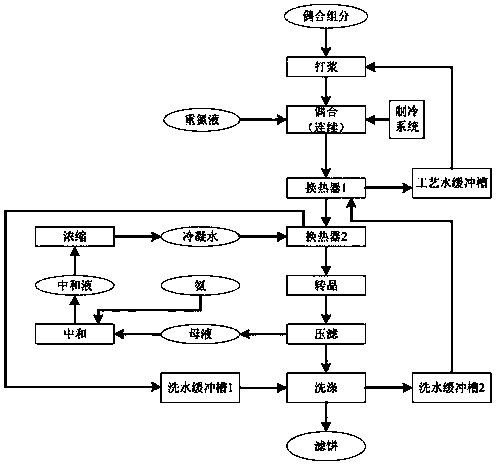Continuous coupling and energy utilization method for dyes
A dye and energy technology, which is applied in the direction of azo dyes, organic dyes, monoazo dyes, etc., can solve the problems of ineffective utilization, low production efficiency, and large consumption of cold and heat energy, and achieve reuse and resource utilization. The effect of improving production efficiency and reducing waste water discharge
- Summary
- Abstract
- Description
- Claims
- Application Information
AI Technical Summary
Problems solved by technology
Method used
Image
Examples
Embodiment 1
[0019] See flow chart figure 1 .
[0020] Beat 995kg of 2-methoxy-5-acetylamino-N,N-diacetoxyethylaniline, 12500L of washing water cooled by heat exchanger 1, and 5kg of auxiliary agent TX-10 to obtain 7.4 % of coupling components beating fluid.
[0021] Continuously pump the above slurry into the first-stage coupling reactor at a flow rate of 3857kg / h, and at the same time inject 30% 2,4-dinitro-6-chloroaniline into the third-stage coupling reactor at a flow rate of 870kg / h Sulfate diazonium salt solution, carry out coupling reaction under stirring, control the folded mole ratio of diazonium salt and coupling component in the feed to 1:1.01, and add 1 to 3 Grade coupling kettle. The output of the first-stage coupling reaction overflows to the second-stage coupling kettle, and the output of the second-stage coupling reactor overflows to the third-stage coupling kettle. The reaction temperature of each coupling kettle is controlled at 0-5°C.
[0022] The output of the three...
Embodiment 2
[0026] Beat 926kg of 3-acetamido-N,N-diethylaniline, 10500L of washing water cooled by heat exchanger 1, and 5kg of auxiliary agent TX-10 to obtain 8.1% beating liquid of coupling components.
[0027] Continuously pump the above-mentioned beating liquid into the first-stage coupling reactor at a flow rate of 3352kg / h, and at the same time inject 30% 2,4-dinitro-6-bromoaniline sulfuric acid into the coupling reactor at a flow rate of 1580kg / h Nitrogen salt, carry out the coupling reaction under stirring, control the molar ratio of diazonium solution and coupling solution to 1:1.03, and the ratio of diazonium solution added in the secondary coupling tank is 7:3. The output of the first-stage coupling reaction overflows to the second-stage coupling kettle, and the reaction temperature of each coupling kettle is controlled at 0-5°C.
[0028] The discharge of the secondary coupling kettle is heat-exchanged with the washing water from the washing water buffer tank 2 in the heat exch...
Embodiment 3
[0031] Embodiment 3: O61#, diazo, coupling liquid add once, yield 98%
[0032] Beat 740kg of N-ethyl-N-cyanoethylaniline, 11500L of washing water cooled by heat exchanger 1, and 5kg of auxiliary agent TX-10 to obtain a 6% beating liquid of the coupling component.
[0033] Continuously pump the above-mentioned beating liquid into the first-stage coupling reactor at a flow rate of 3140kg / h, and inject 30% 2,6-dibromo-4-nitroaniline sulfuric acid into the coupling reactor at a flow rate of 1412kg / h Nitrogen salt, carry out the coupling reaction under stirring, control the molar ratio of the diazonium solution and the coupling solution to 1:1.04, and add all the diazo solution into the first-stage coupling reaction kettle. The output of the first-stage coupling reaction overflows to the second-stage coupling kettle, and the output of the second-stage coupling reactor overflows to the third-stage coupling kettle. The reaction temperature of each coupling kettle is controlled at 0-5...
PUM
 Login to View More
Login to View More Abstract
Description
Claims
Application Information
 Login to View More
Login to View More - R&D Engineer
- R&D Manager
- IP Professional
- Industry Leading Data Capabilities
- Powerful AI technology
- Patent DNA Extraction
Browse by: Latest US Patents, China's latest patents, Technical Efficacy Thesaurus, Application Domain, Technology Topic, Popular Technical Reports.
© 2024 PatSnap. All rights reserved.Legal|Privacy policy|Modern Slavery Act Transparency Statement|Sitemap|About US| Contact US: help@patsnap.com








